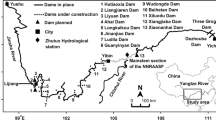Abstract
Dams are effective to prevent flood disasters and effectively use water resources. However, the impact on the ecosystem is concerned, such as the dam blocking the movement of organisms upstream and downstream. Moreover, it is not possible to prevent a disaster once every several 100 years. Originally, it was designed with a balance between disaster risk and ecological risk, and these risks are not completely eliminated. Which risk is to be emphasized changes from decade to decade, and it should be different, for example, between nature reserves and the rivers flowing through large cities. In this chapter, using a generalized linear model, we propose a regression equation that predicts the survival probability of the char population upstream of the dam from the years after the installation of the dam and the catchment area. Using this model, we extrapolated the future extinction risk of local populations. In addition, population viability analysis is performed using life table analysis to predict extinction risk. At that time, we considered the annual fluctuation of the subscription rate. In this way, both statistical analysis based on distribution information and population modelling based on life history parameters suggest that the risk of extinciton increases due to the division of habitat by dams.
Similar content being viewed by others
References
Barneche DR, Robertson DR, White CR, Marshall DJ (2018) Fish reproductive-energy output increases disproportionately with body size. Science 360:642–645
Christensen NL, Bartuska AM, Brown JH, Carpenter S, D’Antonio C, Francis R, Franklin J, MacMahon JA, Noss RF, Parsons DJ, Peterson CH, Turner MG, Woodmansee RG (1996) The report of the Ecological Society of America Committee on the Scientific Basis for Ecosystem Management. Ecol Appl 6:665–691
Dobson AJ, Barnett AG (2018) An Introduction to generalized linear models, 4th edn. Chapman & Hall/CRC, Boca Raton, FL
Dunham JB, Rieman BE (1999) Metapopulation structure of bull trout: influences of physical, biotic, and geometrical landscape characteristics. Ecol Appl 9:642–655
Hart DD, Johnson TE, Bushaw-Newton KL, Horwitz RJ, Bednarek AT, Charles DF, Kreeger DA, Velinsky DJ (2002) Dam removal: challenges and opportunities for ecological research and river restoration. Bioscience 52(8):669–681
Hesthagen T, Sandlund OT (1995) Current status and distribution of Arctic char Salvelinus alpinus (L.) in Norway: the effects of acidification and introductions. Nordic J. Freshw Res 71:275–295
Jager HI, Chandler JA, Lepla KB, Van Winkle W (2001) A theoretical study of river fragmentation by dams and its effects on white sturgeon populations. Environ Biol Fish 60:347–361
Katsukawa Y, Katsukawa T, Matsuda H (2002) Indeterminate growth selected by a trade-off between high fecundity and risk avoidance in stochastic environment. Pop Ecol 44:265–272
Kitano S (1997) Intrapopulation variation in growth and reproduction of fluvial dolly varden. Doctoral thesis, Hokkaido University (in Japanese).
Matsuda H, Morita K (2003) Environmental risk of biological organisms. In: Nakanishi J, Masunaga S, Matsuda H (eds) Calculating environmental risks. Iwanami-Shoten, Tokyo, pp 159–168 (In Japanese)
Morita K, Yamamoto S (2002) Effects of habitat fragmentation by damming on the persistence of stream-dwelling charr populations. Cons Biol 16(5):1318–1323
Morita K, Yokota A (2002) Population viability of stream-resident salmonids after habitat fragmentation: a case study with white-spotted charr (Salelinus leucomaenis) by an individual based model. Ecol Model 155:85–94
Morita K, Sahashi G, Miya M, Kamada S, Kanbe T, Araki H (2019) Ongoing localized extinctions of stream-dwelling white-spotted charr populations in small dammed-off habitats of Hokkaido Island, Japan. Hydrobiologia 840:207–213
Miura T (1977) Population dynamics. In: Osawa F (ed) Population and ecology, biological science lecture 8. Asakura-shoten, Tokyo pp 38–104 (in Japanese)
Washitani I, Takenaka A, Kuramoto N, Inoue K (1997) Aster kantoensis Kitam. an endangered flood plain endemic plant in Japan: Its ability to form persistent soil seed banks. Biol Conserv 82:67–72
Water Resources Organization Tokuyama Dam Management Office (2013) Conservation of the environment at Tokuyama Dam - evaluation of survey results and predictions on rare birds of prey, pp 159 (in Japanese)
Acknowledgments
I thank Dr. Junko Nakanishi and Shigeki Masunaga for collaboration of the previous article.
Author information
Authors and Affiliations
Editor information
Editors and Affiliations
Rights and permissions
Copyright information
© 2021 The Author(s), under exclusive license to Springer Nature Singapore Pte Ltd.
About this chapter
Cite this chapter
Matsuda, H., Morita, K. (2021). Effects of Dams on Ecological Risk of Inland Fishes. In: Matsuda, H. (eds) Ecological Risk Management. Ecological Research Monographs. Springer, Singapore. https://doi.org/10.1007/978-981-33-6934-4_15
Download citation
DOI: https://doi.org/10.1007/978-981-33-6934-4_15
Published:
Publisher Name: Springer, Singapore
Print ISBN: 978-981-33-6933-7
Online ISBN: 978-981-33-6934-4
eBook Packages: Biomedical and Life SciencesBiomedical and Life Sciences (R0)




